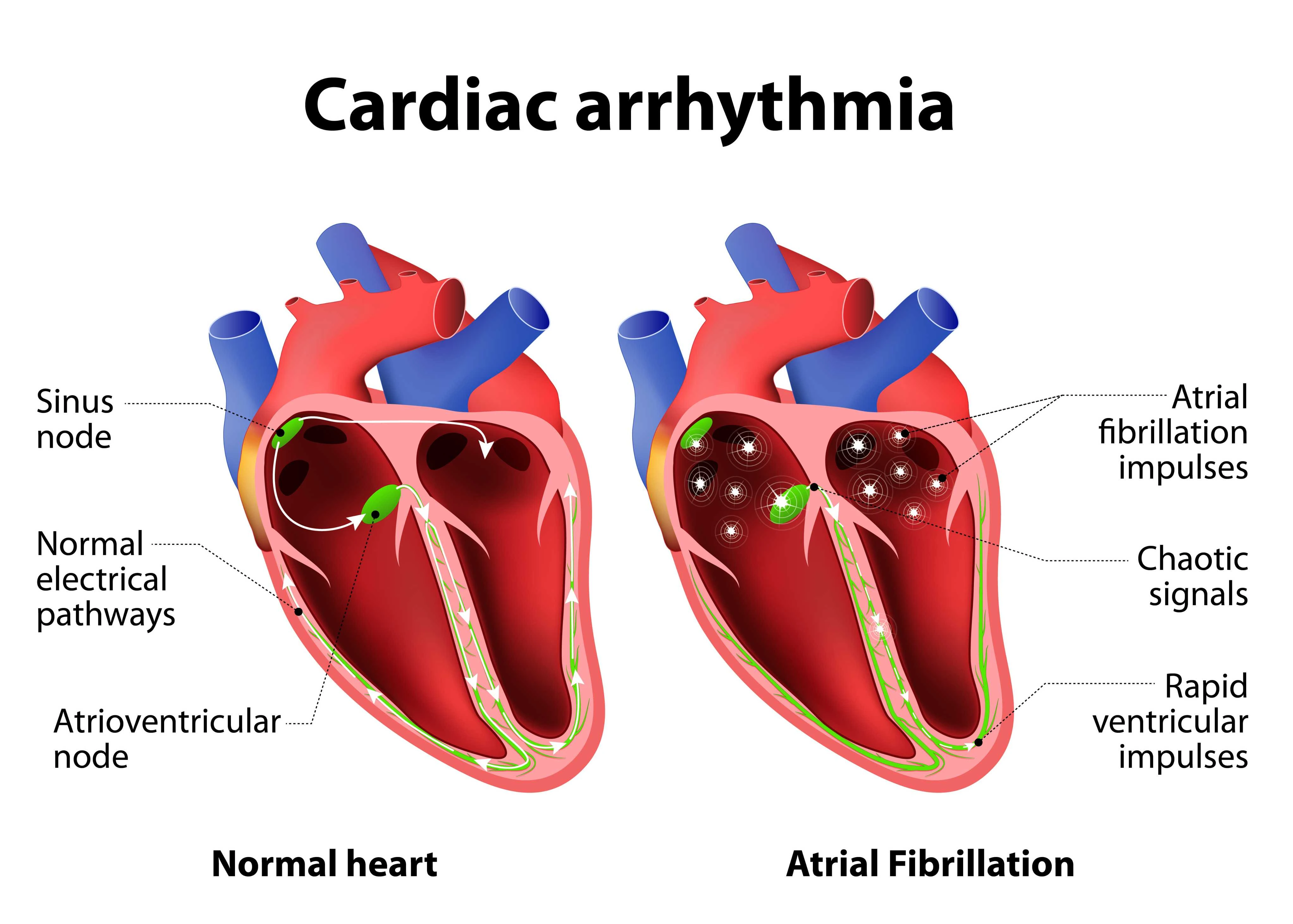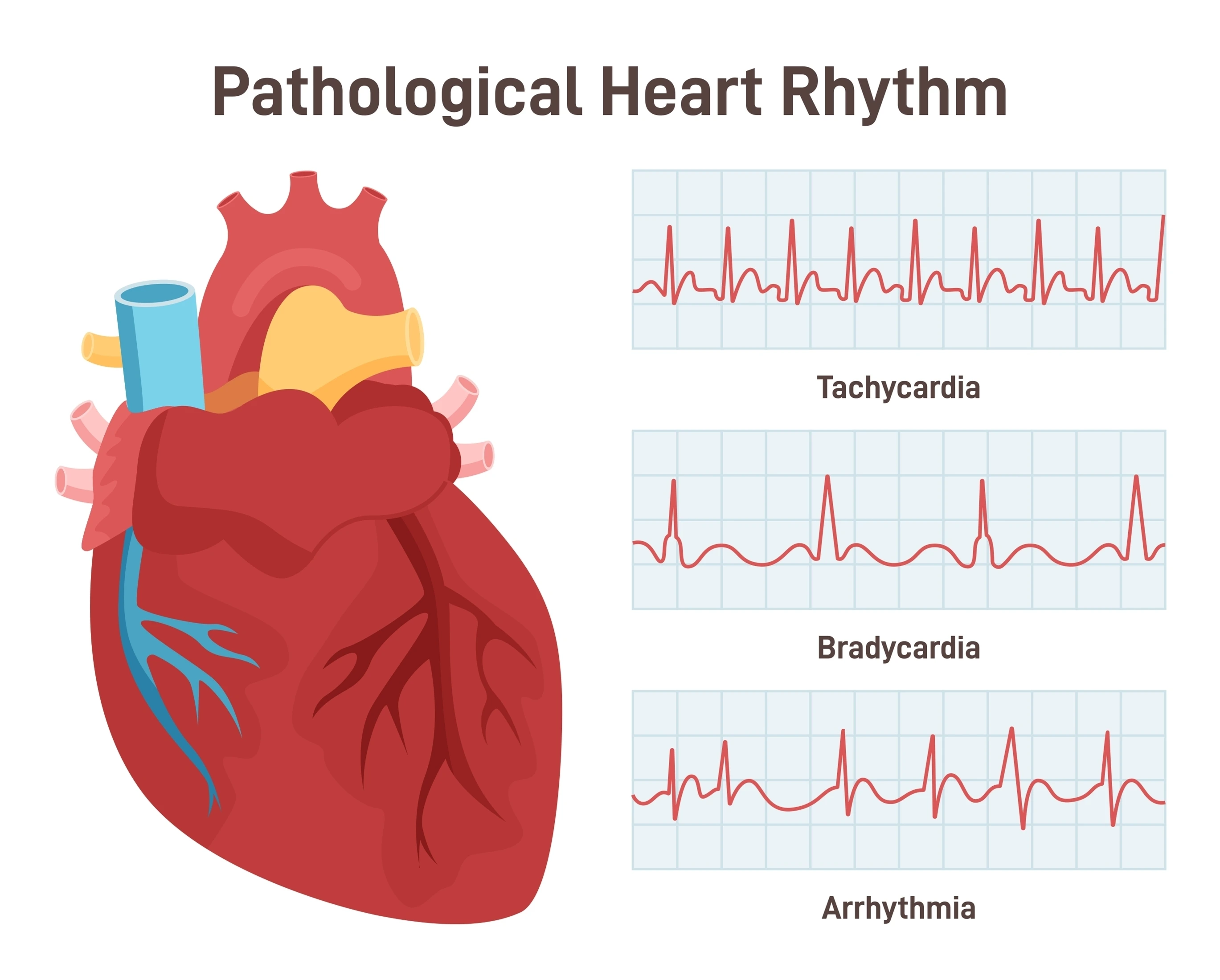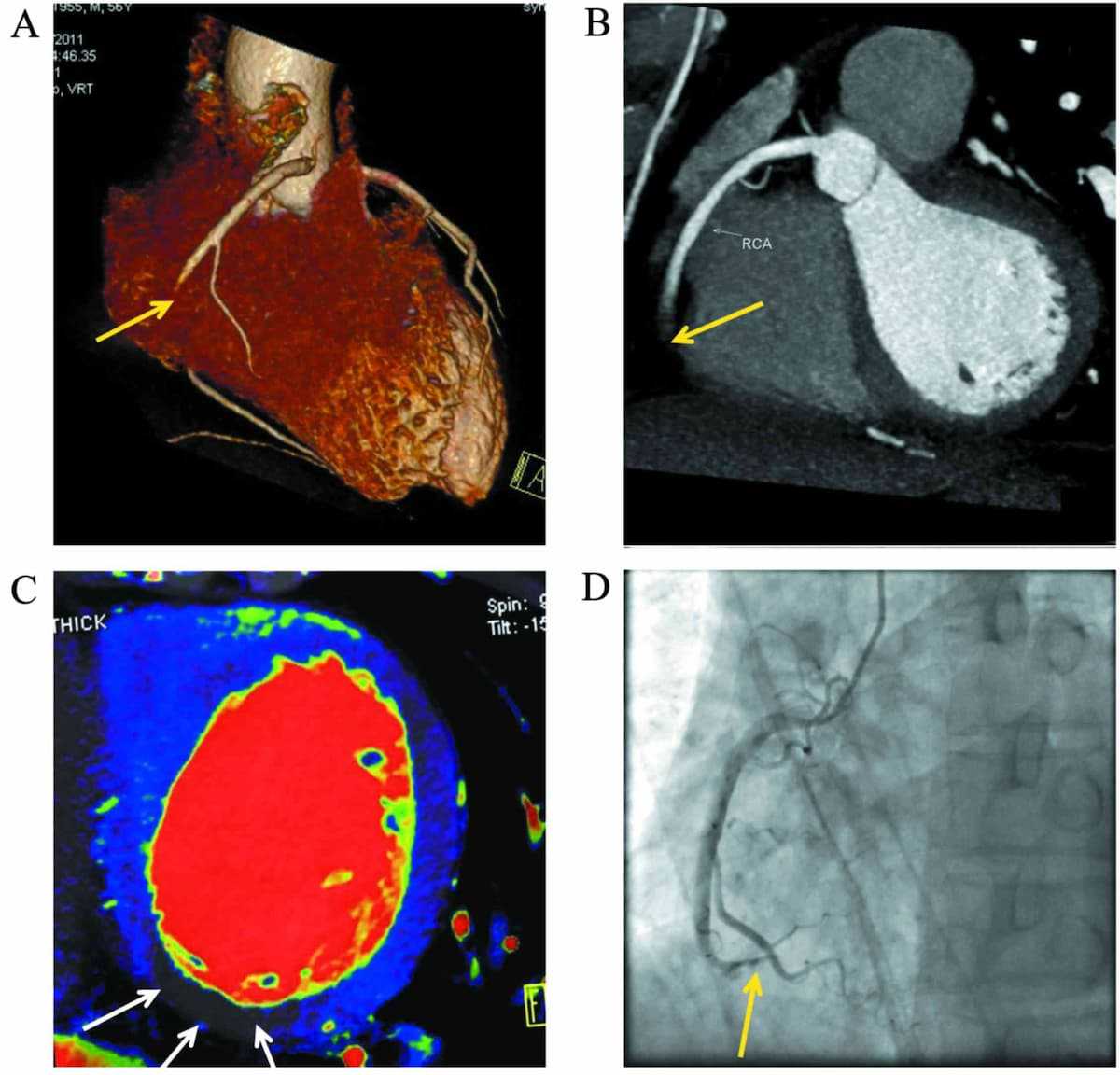ARRHYTHMIA


What Is Arrhythmia?
Arrhythmia is a medical condition characterised by irregular heart rhythms. In this condition, the heart's natural rhythm and coordination of heartbeats are disrupted, leading to deviations from the normal heart beat.
Read more about it below or you may book an appointment for a cardiac evaluation with one of our cardiologists or contact us for further details to schedule your test.

Know About Arrhythmia and Its Types
There are several types of arrhythmia. Atrial fibrillation (AFib) stands as the most prevalent type of arrhythmia. This condition arises when the heart's upper chambers experience irregular contractions, causing an erratic heartbeat. The heart may struggle to maintain a regular rhythm, significantly affecting the individual's overall heart function.
Ventricular tachycardia is a rapid rhythm in the heart's lower chambers. This abnormal electrical activity can lead to a significantly accelerated heart rate, potentially compromising the heart's ability to pump blood effectively. Bradycardia represents an abnormally slow heart rate, leading to dizziness, fatigue, and fainting.
Causes and Symptoms of Arrhythmia
Arrhythmia can stem from various causes. These may include underlying heart conditions, electrolyte imbalances, or external factors like stress. The symptoms can range from palpitations, shortness of breath, and dizziness to more severe manifestations like chest pain or fainting.
Diagnosing Arrhythmia
Diagnosing arrhythmia involves essential steps to identify irregular heart rhythms accurately. Medical professionals often employ electrocardiograms (ECGs) to record the heart's electrical activity and detect abnormalities. Also Holter monitors, portable ECG devices, can provide extended monitoring to capture intermittent arrhythmias.
Advanced diagnostic tools like cardiac event recorders and electrophysiology studies are used to delve deeper into the nature of the arrhythmia, enabling tailored treatment approaches based on precise diagnosis.
Treatment Options for Heart Arrhythmia
Treating heart arrhythmia involves tailored strategies, ranging from lifestyle adjustments and medications to procedures like catheter ablation. In some cases, implantable devices such as pacemakers are crucial in maintaining a healthy heart rhythm and preventing severe complications.
What Are the Risk Factors for Developing Arrhythmia?
Arrhythmia includes a range of symptoms and potential health risks. Understanding arrhythmia and its associated risk factors is crucial for medical professionals and individuals seeking to maintain cardiovascular health.
Identifying the Common Risk Factors
Several common risk factors can increase the likelihood of developing arrhythmia. These factors include age and changes in the heart's structure and function, which might sometimes necessitate surgery to correct or manage. Hypertension (high blood pressure) is another key risk factor. Elevated blood pressure strains the heart and its electrical system, increasing the likelihood of arrhythmias.
Metabolic factors also play a role. Conditions like diabetes and thyroid disorders can disrupt the balance of electrolytes and hormones in the body. Substance abuse, including excessive alcohol consumption and illicit drug use, can trigger arrhythmias by disrupting the heart's normal rhythm.
How Heart Conditions Can Lead To Arrhythmia?
A family history of arrhythmias or congenital heart conditions such as coronary artery disease can increase the risk. Narrowed arteries and compromised blood flow can interfere with the heart's electrical signals. Similarly, heart valve problems hinder the heart's efficient ability to pump blood, which triggers changes in the heart's electrical activity.
Preventing Heart Arrhythmias
Engaging in regular physical activity helps overall cardiovascular health. It enhances blood circulation, promoting efficient oxygen and nutrients delivery. Adopting a heart-nourishing diet that is low in sodium also helps maintain optimal blood pressure, thus supporting the heart's rhythm stability. Incorporating stress-reduction practices such as meditation, deep breathing, or yoga can help quell the impact of stress on the heart's rhythm.
Recognizing Symptoms and Causes of Arrhythmia
Palpitations, fluttering, or skipping beats often serve as an initial sign. Dizziness, lightheadedness, chest discomfort, shortness of breath, and unexplained fatigue may also manifest. Sudden loss of consciousness and weakness can result from irregular heart rhythms, with confusion and mental cloudiness occasionally accompanying these episodes.
Its origin is traced to various underlying factors, such as age-related changes in the heart's electrical system and coronary artery disease. Genetic factors, namely metabolic imbalances from diabetes or thyroid disorders, excessive alcohol consumption, substance abuse, certain medications, hypertension, stress, electrolyte imbalances, sleep apnea, infections, and chronic conditions such as lung diseases, can all contribute.
Understanding the Impact of Abnormal Heart Rhythm
Abnormal heart rhythms lead to various consequences, from mild discomfort to life-threatening issues. They compromise blood circulation, causing symptoms like palpitations, dizziness, and fatigue. Untreated, they elevate the risk of blood clots, potentially causing stroke or weakening the heart muscle and leading to heart failure.
Interpreting ECG Results
Interpreting ECG results requires professional expertise as it involves analysing the complex patterns and rhythms of the heart. A trained cardiologist or healthcare provider can assess the ECG tracings and determine whether the heart's electrical activity is normal or abnormal.
Understanding Normal and Abnormal Heart Rhythms
A normal ECG will show a regular and coordinated pattern of electrical activity, indicating a healthy functioning heart. However, an abnormal ECG can indicate various heart conditions, such as arrhythmias, heart attacks, or structural abnormalities.
How an ECG Machine Diagnoses Heart Diseases?
An ECG machine plays a crucial role in diagnosing heart diseases. By analysing the ECG tracings, medical professionals can identify abnormal heart rhythms, detect signs of previous heart attacks, determine the effectiveness of heart medications, and monitor the progress of heart conditions over time.
Significance of ECG in Detecting Coronary Issues
One of the primary uses of an ECG is detecting coronary artery disease, which is characterised by reduced blood flow to the heart muscle. Changes in the ECG patterns can indicate a lack of oxygen to the heart, suggesting the presence of blocked or narrowed coronary arteries.
What Are the Different Types of Arrhythmia?
Exploring the different types of heart rhythms, broadly categorized into tachyarrhythmias (fast heart rhythms) and bradyarrhythmias (slow heart rhythms), arrhythmias manifest in several distinct forms:
- Atrial Fibrillation (AFib): Characterized by rapid, irregular electrical signals in the heart's upper chambers. It can cause blood clots and increase the risk of stroke.
- Supraventricular Tachycardia (SVT): Often causing rapid heart rates that can come and go suddenly. SVTs are generally not life-threatening but can be uncomfortable.
- Ventricular Tachycardia (VTach): VTach leads to a fast, regular heartbeat that can be potentially life-threatening, especially if sustained.
- Ventricular Fibrillation (VFib): VFib involves chaotic, rapid electrical impulses in the ventricles. It leads to ineffective pumping and can result in sudden cardiac arrest if not promptly treated.
- Bradycardia: These encompass slow heart rhythms, often caused by issues in the heart's electrical system that might require medical attention if symptoms arise.

Exploring Atrial Fibrillation
Atrial fibrillation (AFib) leads to blood stagnation and potential clot formation, raising the risk of stroke. AFib's origins are diverse, encompassing age, hypertension, heart disease, obesity, and genetics. Age-related wear on the heart's electrical system, underlying heart conditions, and metabolic disturbances also contribute to its development.
Techniques like electrocardiograms and Holter monitoring are used to identify heart rhythm. Given AFib's potential complications, treatment focuses on restoring normal rhythm, employing medications and procedures like catheter ablation, and preventive measures, especially anticoagulants, crucial for reducing clot-related risks.
Understanding Ventricular Fibrillation
Ventricular fibrillation is a critical and life-threatening cardiac arrhythmia where the heart's lower chambers quiver erratically, blocking blood from being effectively pumped to the body and brain. The consequence is a sudden loss of circulation and consciousness, requiring immediate intervention.
Frequently associated with underlying heart conditions, the erratic electrical impulses resulted in the ineffective contraction of the lower heart chambers, compromising the heart's primary function of maintaining blood flow. Prompt recognition and intervention, often through defibrillation, are vital.
Tachycardia - A Rapid Heart Rhythm Disorder
Tachycardia involves an abnormal increase in heart rate that surpasses the typical resting pulse. It can disrupt the heart's natural sequence and affect its ability to pump blood throughout the body efficiently. Understanding the pathological causes of tachycardia is crucial. It may stem from various triggers, including physiological stress, electrolyte imbalances, fever, anaemia, or the influence of elevated adrenaline levels due to factors like anxiety or specific medications.
The effects of tachycardia can range from sensations of palpitations, dizziness, shortness of breath, and fainting to chest discomfort. The condition's duration and the presence of underlying heart issues determine whether tachycardia is transient or persistent. Timely diagnosis is crucial, and management approaches may involve addressing root causes, making lifestyle adjustments, utilizing medications, or, in some cases, employing procedures to restore the heart rhythm.
Bradycardia - A Slow Heart Rhythm Disorder
A resting heart rate below 60 beats per minute defines bradycardia, stemming from factors like ageing or medical conditions such as electrolyte imbalances, hypothyroidism, and heart damage. Consequences of bradycardia vary from mild symptoms like dizziness to severe outcomes like fainting or cardiac arrest.
Arrhythmia in Different Chambers of the Heart
Arrhythmias manifest in distinct heart chambers, carrying varying cardiovascular implications. Atrial fibrillation originates in the atria, raising stroke risks. Ventricular arrhythmias, like ventricular tachycardia, arise in lower chambers, often signalling compromised heart function and potential cardiac arrest.
What Are the Symptoms of Arrhythmia?
Irregular heartbeats specifically denote variations in the heart's beat intervals. However, abnormal heart rhythm encompasses a broader concept referring to deviations from the heart's standard electrical patterns, including irregular heart beats and other complex rhythm abnormalities like atrial fibrillation, ventricular tachycardia, and bradycardia.
Irregular Heartbeats and Abnormal Heart Rhythm
Irregular heartbeats specifically denote variations in the heart's beat intervals. However, abnormal heart rhythm encompasses a broader concept referring to deviations from the heart's normal electrical patterns, including irregular beats and other complex rhythm abnormalities like atrial fibrillation, ventricular tachycardia, and bradycardia.
Premature Heartbeats and Skipped Beats
Premature heartbeats occur when the heart's rhythm speeds up momentarily, often leading to a fluttering sensation. While skipped beats involve a brief pause in the heart's rhythm, creating the sensation of a missed beat.
Racing Heart and Palpitations
A racing heart (tachycardia) is a rapid increase in heart rate, often making the heart feel like it's racing. Conversely, palpitations are irregular heartbeats that might feel like fluttering, pounding, or a skipped beat. Both sensations can arise from factors like stress, caffeine, or arrhythmias.
Investigating the causes of heart palpitations, which may range from emotional stress to underlying heart conditions, is a key step in diagnosing arrhythmias.
Feeling Like Your Heart Is Skipping a Beat
The feeling of your heart skipping a beat can be disconcerting, characterized by a momentary pause followed by a more forceful heartbeat. These sensations can stem from stress, caffeine, or hormonal shifts. While occasional instances are harmless, ongoing or repetitive sensations warrant professional evaluation.
Dizziness, Fainting, and Shortness of Breath
Dizziness, fainting, and shortness of breath are significant symptoms often associated with cardiac irregularities. Dizziness might stem from inadequate blood supply to the brain due to irregular heart rhythms. Fainting, or syncope, can result from sudden drops in blood pressure or reduced blood flow caused by arrhythmias. Shortness of breath can occur when the heart's inefficiency compromises oxygen delivery.
How Is Arrhythmia Diagnosed?
The intricate rhythm of the heart can vary significantly among individuals. A range of diagnostic tools and assessments, such as Holter monitoring (ECGs), Holter monitoring, and electrophysiological studies, each method plays a pivotal role in the precise diagnosis of arrhythmia, enabling the initiation of targeted interventions for optimal cardiac health.
Treatment Options for Heart Arrhythmia
Managing heart arrhythmia entails a variety of treatments, ranging from lifestyle adjustments to medical interventions and advanced procedures. A holistic approach is vital in addressing this complex condition.
Medical Treatments for Arrhythmia
Medications for Controlling Arrhythmia
Antiarrhythmic drugs, such as beta-blockers, calcium channel blockers, and sodium channel blockers, influence the heart's electrical signals. These medications aid in restoring normal heart rhythm, preventing irregular beats, and reducing the risk of complications.
Antiarrhythmic Drugs and Their Effects
Antiarrhythmic drugs target the heart's electrical system to restore normal rhythm and prevent arrhythmia recurrence. They modify ion channels and electrical signals, helping the heart maintain a steady beat.
Rate Control vs. Rhythm Control Strategies
Rate control aims to maintain a controlled heart rate, often through medications, to alleviate symptoms and enhance overall function. Rhythm control focuses on restoring and maintaining a regular heart rhythm, utilising treatments like medications or procedures.
Invasive Procedures and Interventions
Catheter Ablation for Arrhythmia
In catheter ablation, a catheter is threaded through blood vessels to the heart, where radiofrequency or cryotherapy is employed to aid the areas. Disrupting the abnormal pathways offers a potential solution for restoring a normal heart rhythm.
Implantable Devices: Pacemakers and Defibrillators
Pacemakers, equipped with electrical circuits, send regular impulses to regulate heartbeats in cases of bradycardia. Conversely, defibrillators monitor heart rhythms and deliver corrective shocks if life-threatening arrhythmias, like ventricular fibrillation, are detected.
Cardiac Resynchronization Therapy (CRT)
Cardiac resynchronisation therapy (CRT) is a treatment that uses a pacemaker to coordinate the beating of the heart's two lower chambers. CRT can improve symptoms, such as shortness of breath and fatigue, and reduce the risk of hospitalisation.
Surgical Interventions for Severe Cases
Severe cases of heart disease may require surgical intervention. These interventions can include coronary artery bypass grafting (CABG), heart valve replacement, or heart transplant. The specific procedure that is performed will depend on the individual's condition.
Lifestyle Changes and Non-Medical Approaches
Role of Diet and Exercise in Managing Arrhythmia
Diet and exercise play an important role in managing arrhythmia. A healthy diet can help to control blood pressure and cholesterol levels, which are risk factors for arrhythmia. Exercise can help to improve heart health and reduce stress, which can also trigger arrhythmia.
Stress Reduction and Its Impact on Heart Rhythm
When people are stressed, their heart rate and blood pressure can increase, leading to irregular heartbeats. Stress reduction techniques, such as yoga, meditation, and deep breathing, can help to lower heart rate and blood pressure and improve heart rhythm.
Avoiding Triggers and Managing Underlying Conditions
Avoiding triggers include smoking, stress, and obesity and managing underlying conditions such as high blood pressure, high cholesterol, and diabetes can also increase the risk of cardiovascular disease.
Importance of Regular Follow-up and Monitoring
Regular follow-up and monitoring are important to ensure stability and detect any changes early. This can help to prevent complications and improve the chances of a good outcome.
Frequently Asked Questions About Arrhythmia
Navigating the complexities of arrhythmia, an irregular heartbeat condition, often raises questions among individuals seeking to understand its implications and management. Those are:
What Are the Main Causes of Arrhythmia?
Arrhythmia can be caused by a variety of factors, including disruption by age-related changes, underlying heart conditions, genetics, metabolic imbalances, and lifestyle factors. For example, coronary artery disease, diabetes, thyroid disorders, excessive alcohol consumption, drug use, certain medications, hypertension, stress, sleep apnea, infections, and chronic conditions can also contribute to arrhythmia.
Is Arrhythmia Life Threatening?
Certain types of arrhythmias can indeed be life-threatening, such as ventricular fibrillation, which can lead to sudden cardiac arrest, needing immediate medical attention. Some arrhythmias are benign and pose little to no immediate threat to life, such as premature ventricular contractions (PVCs) and premature atrial contractions (PACs).
What Are the Symptoms of Arrhythmia?
Arrhythmia symptoms cover a broad spectrum, from mild palpitations, occasional dizziness, and shortness of breath to severe manifestations like chest pain and sudden fainting. Recognizing symptom severity helps guide diagnosis and treatment decisions for this cardiac condition.
What Are Some Arrhythmia Risk Factors?
Several common risk factors can increase the likelihood of developing arrhythmia. These factors include age, changes in the heart's structure and function, and hypertension. Metabolic factors also play a role, such as diabetes, thyroid disorders, and substance abuse can all disrupt the heart’s normal rhythm.
Can Arrhythmia Be Cured?
While complete eradication of all arrhythmic occurrences might not always be attainable. Advancements in medical interventions have led to effective management strategies that aim to control symptoms, improve the quality of life, and minimize the impact of arrhythmia. Lifestyle changes such as dietary modification, regular exercise, and stress management amongst many others are suggested.
Is Arrhythmia a Serious Heart Condition?
The severity of arrhythmia can vary greatly. Some cases are harmless and cause little discomfort, while others can be serious and pose a health risk that disrupts the blood flow to the heart, brain, and other organs, increasing the risk of stroke, heart failure, and sudden cardiac arrest.
What Is the Most Common Arrhythmia You Will See in Patients?
The most common is atrial fibrillation (AFib), a condition where the heart’s two upper chambers beat irregularly and chaotically, compromising the heart’s efficiency and increasing the risk of blood clot formation.
What is the difference between tachycardia and bradycardia?
Tachycardia and bradycardia are both heart rhythm disorders, with tachycardia characterised by a fast heart rate over 100 beats per minute, and bradycardia defined by a slow heart rate under 60 beats per minute. The difference lies in the heart rate speed, impacting how blood is circulated in the body.
What Triggers Arrhythmia?
Arrhythmias are stress, excessive caffeine or stimulant consumption, alcohol abuse, tobacco and nicotine use, and high blood pressure. These factors can disrupt the heart's electrical system and lead to irregular heart rhythms, especially in individuals with underlying heart conditions. Electrolyte imbalances, genetics, age, and family history also contribute.
How Are Arrhythmias Diagnosed?
Arrhythmias are diagnosed through a range of diagnostic tools, including electrocardiograms (ECGs), which record the heart's electrical activity, Holter monitors for extended monitoring, and event monitors to capture intermittent arrhythmias. Electrophysiological studies offer in-depth insights into arrhythmia mechanisms, while cardiac imaging, stress tests, and blood tests may provide valuable information about underlying causes and associated conditions.
Can You Live a Normal Life With Arrhythmia?
Many individuals with arrhythmias can live normal and fulfilling lives with proper management and treatment. The extent to which one can maintain a normal life largely depends on the type and severity of the arrhythmia, overall health, and how well the condition responds to treatment.
Conclusion
In conclusion, arrhythmia can range from mild discomfort to serious health risks. It disrupts the heart's natural rhythm and coordination, affecting individuals of all ages. If you're looking for arrhythmia treatment in Singapore, The Harley Street Heart and Vascular Centre, our team of highly skilled cardiology experts uses cutting-edge facilities to diagnose and treat complex heart problems. We personalize our treatments to meet your unique needs to maintain the health of your heart. Book an appointment or teleconsultation today to put your heart's well-being first.


